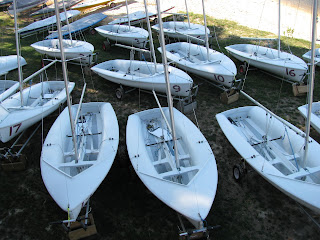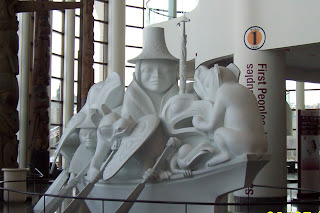Down the Potomac, Over to Tangier Island and Back to Deltaville – October 2 to 9, 2010
We had been quite proud of the 100% success rate with our 35 pound Delta anchor system since we began our trip over a year ago. That changed when we dragged anchor in the Washington Channel in DC and had a close call from an unmanned boat that sped past us backwards dragging a Delta along the bottom and headed directly for a nearby mega yacht. We now have a 33 pound Bruce as our primary anchor and it has passed the tests so far.
Our first anchorage after leaving Washington was amongst the crab pots on Potomac Creek, a branch of the Potomac River. If we had dragged there we would have had quite a tangled mess. The next night we were back at St Mary’s City where we had arranged to meet Mac and Ruth on Carmella. We rafted together for the night and had a wonderful spontaneous (the best kind) pot luck dinner with the gang on Carmella. Carmella weighs 28,000 pounds, Polar Pacer weighs 12,000 pounds. Little Bruce held us both just fine.
Rafted
The tug and barge relay. One came from each direction. The barges met nose to nose and the big tug left the little tug to handle them both.
We wanted to fill our diesel tanks and sit out some rainy weather before we headed off to Tangier Island so we followed Carmella home to Kinsale Harbour. During a break in the rain we pulled the Dubarry boots out of storage and headed down the highway on foot to find a convenience store. When we were almost there, Kip and Linda, a couple of boaters that we had not yet met, recognized us from the marina and stopped to offer us a ride. Five hours later we had skipped the convenience store, went with them to Ace Hardware in the next town, bought supplies at the ABC liquor outlet, stopped at MacDonalds for lunch, picked up groceries from Walmart in another town, went with them to their home to see the boat they are rebuilding and some lovely hooked rugs and patchwork quilts that were in progress. Then they took us back to the marina where we spent another hour visiting each other’s boats. They were wonderful company and the rainy day was over before we knew it. They also own a boat transport business based in Virginia. If you need a boat moved anywhere in North America, give them a call at Boat Lovers Transport: 804-472-9223.
When you leave the mouth of the Potomac and head due east you will arrive at Tangier Island after four or five hours. You won’t see it until you are almost there. The island is very low and flat with the highest point of land being about 4 or 5 feet above sea level.
Approaching Tangier island from the west.
When you arrive by boat there is really only one place to stay – Mr. Parks Marina. Besides electricity and water, the very reasonable docking fees include Mr. Parks guided tour of the island on his golf cart built for two. And when you pay your fees at the end of your stay Mr. Parks will try to give you your money back because he does not think he did enough for you while you were there.
Polar Pacer at Parks Marina
Tangier Island is a community whose economy still depends almost entirely on the water. Soft-shell crab is one of their specialties.
Crab traps ready to be set.
These peeler shacks on stilts are where crabs are kept in tanks until they molt and shed their hard shells.
Tangier island also has a few seasonal restaurants and B&B’s to serve the small tourist industry. Hilda Crockett’s Chesapeake House with its family style meals has been in business for 71 years. The menu is the same every day for both lunch and dinner and yes, she does serve crab cakes.
This lady told us that she was preparing blue crab meat to sell to one of the local restaurants. When her husband brings home the days catch she cleans and steams them, refrigerates them overnight and removes the meat in the morning.
How many blue crab to make a crab cake?
How to steam Blue Crabs: According to the North Carolina department of Agriculture & Consumer Services
Make sure crabs are lively before placing in a pot. Discard any crabs that appear dead. The crab pot should have a raised rack a minimum 2 inches high. Add equal quantities of water and vinegar to just below the level of the rack. Layer crabs; sprinkle each layer with a mixture of seafood seasoning and salt. Cover and steam until the crabs are red (about 25 minutes).
There are few automobiles on the island. The quickest way to get around is by boat, golf cart or bicycle. We walked the length of both streets on the island and took the dinghy through the water courses that crisscross
the land.
We went aground with the dingy more than once and had to use the oars to pole ourselves through the mud. Polar Pacer is the shorter of the two masts.
Automobiles on the island that need repairs are precariously loaded crosswise on the supply boat using two by fours for ramps and taken to the mainland for service.
The parking lot at the ferry dock.
Usable vacant land is scarce. As a result, many homes have graves in their front yards to reduce the risk of the caskets floating away with high tides.
There seemed to be as many cats as there are people. Mr. Parks claimed to have 27 cats.
We only counted 14.
For such a small island it still had a long deserted sandy beach.
Sunrise over the peeler shacks.
From Tangier Island we headed back to Deltaville to pick up a new solenoid for our electric windlass. The one that had been ordered for us in Washington DC didn’t fit and arrangements were made to pick up a replacement from West Marine. We managed to sail about halfway back across the bay before the sails came down and the diesel took over.
When kids get bored …….
Rova kept an eye on us as we crossed the bay.
In Deltaville, our new friends very generously offered the use of the dock next to Rova and invited us to share margaritas and guacamole with them at their cottage after they drove us around to run errands. Emma and Jack – It was so nice to meet you and your parents and spend some of our adventure with you. It is chance meetings with such wonderful people that make this lifestyle so enjoyable.








































